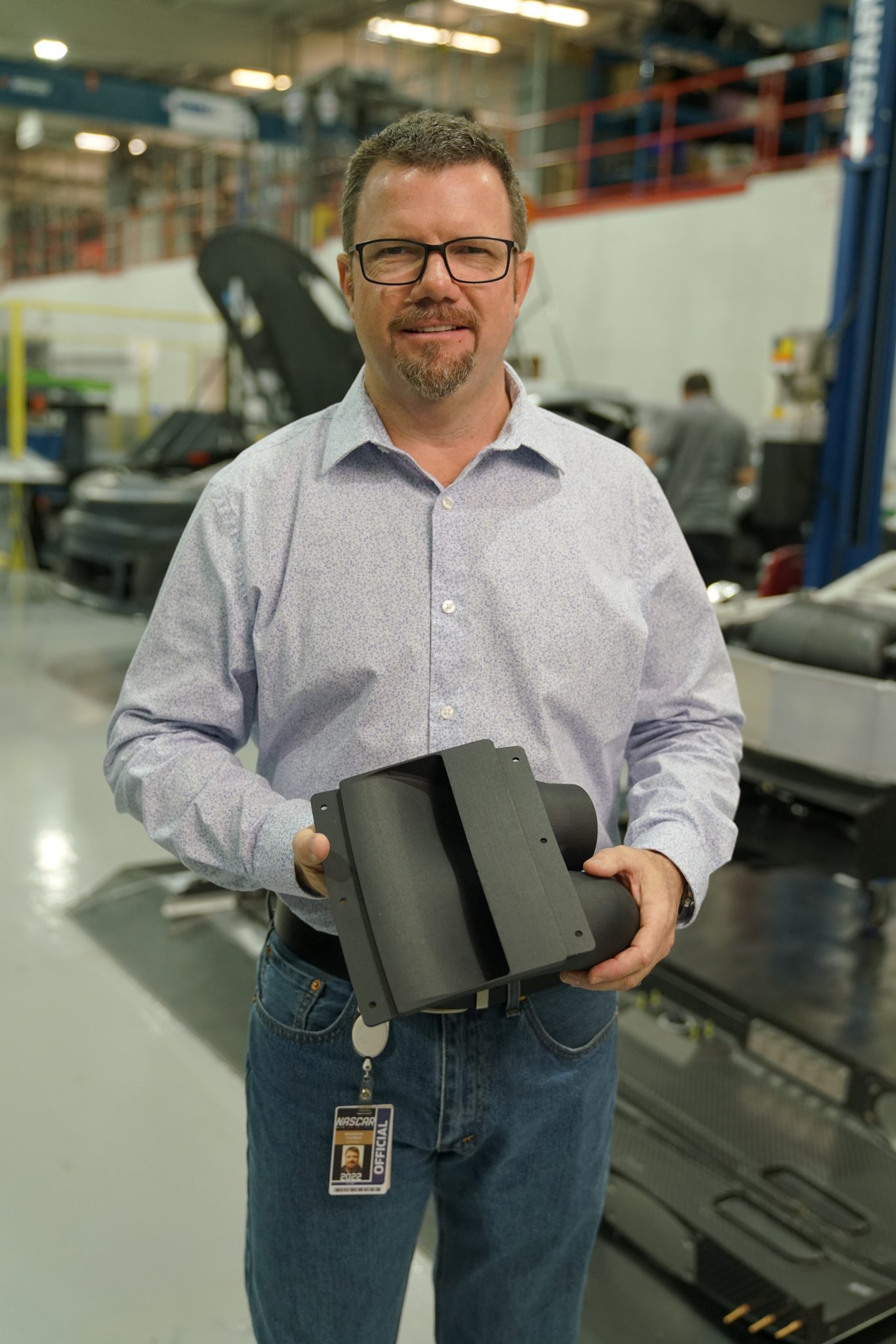Stratasys has been named a NASCAR Competition Partner and has teamed up with NASCAR to produce the first-ever 3D printed production parts to be featured across all NASCAR Next Gen cars.
NASCAR has teamed up with Stratasys Direct Manufacturing to print a windshield air cockpit ventilation unit for the Next Gen car. The windshield air ducts were printed at Stratasys Direct Manufacturing in Belton, Texas on the SAF-powered Stratasys H350 3D printer – which offers production consistency, a competitive and predictable cost per part, and complete production control for volumes up to thousands of parts. The parts were printed using Stratasys High Yield PA11, which is derived from sustainable castor oil. The parts were cleaned, finished, dyed, and shot-blasted using DyeMansion post-processing equipment.
 NASCAR Next Gen car designer holding the 3D printed windshield air cockpit ventilation unit
NASCAR Next Gen car designer holding the 3D printed windshield air cockpit ventilation unit
In addition to this, the team at NASCAR designed and 3D printed an underside NACA duct for engine cooling at their research and development facility in Concord, N.C. with the Stratasys Fortus 450mc 3D printer.
“It is exciting to see the evolution of how NASCAR has used additive manufacturing across their vehicles. We’ve helped them move from 3D printed prototypes to end-use production parts on their high-performance racecars,” said Pat Carey, Senior Vice President, Strategic Growth for Stratasys. “We are honored to be named a NASCAR Competition Partner and to provide all teams with the first end-use production parts for their Next Gen cars. This partnership is a natural extension of the relationship we’ve built over nearly 18 years with NASCAR teams like Joe Gibbs Racing and Penske Racing. These teams have been quick to adopt cutting-edge technologies to enhance their car designs and provide performance advantages, and now we’re happy to support the expansion to all NASCAR Next Gen cars.”
Manufacturing on Demand
The new 3D printed parts save costs, and provide NASCAR with enhanced performance, flexibility, improved aerodynamics, and are being used by every team that competes in the NASCAR Cup Series. The parts are a result of nearly three years of planning, design, and development, as the Next Gen car underwent more than 37,000 miles of testing before its introduction in February.
“The Next Gen car could not have been completed without the collaboration with NASCAR Competition Partners like Stratasys and Stratasys Direct Manufacturing,” said John Probst, Senior Vice President of racing innovation at NASCAR. “During testing, we realized we needed an additive manufacturing solution that could withstand high temperatures and needed the parts delivered quickly. We approached Stratasys Direct, and they delivered not only as a supplier but as a consultant on this project. They provided us with strategic direction on design, materials, and the right additive manufacturing technologies to use to create the highest performance parts for the Next Gen cars.”
Stratasys has partnered with NASCAR teams for almost 20 years to support their endeavors in creating highly competitive race cars – using 3D printing technology to support tooling, drill guides, and now production parts.
“Having worked with Stratasys for more than 18 years, we’re continually impressed by the quality, speed, and flexibility that additive manufacturing offers,” said Joe Gibbs, Founder, and CEO of Joe Gibbs Racing Team. “Our work together has helped move the racing world forward through new technologies that improve the sport.”
You might also like:
Toyota Racing Development (TRD) names Stratasys as official partner:
* This article is reprinted from 3D Printing Media Network. If you are involved in infringement, please contact us to delete it.
Author: Edward Wakefield

Leave A Comment